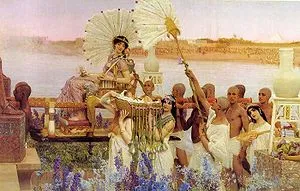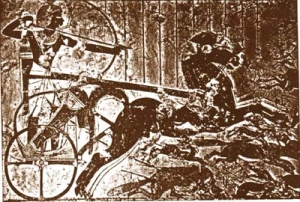Pharaohs of the Israelite Oppression
The period when the Israelites were oppressed in Egypt corresponds to the 12th dynasty of Egypt.
The pharaohs of the 12th dynasty required a large slave labour force for the construction of their pyramids and other public works.
The Pyramids of the 12th dynasty, unlike those of earlier dynasties, were made almost entirely of mud bricks which were finished with a limestone veneer. Over the centuries, the limestone veneer has fallen away due to erosion, earthquakes and pilfering. What remains is the inner cores of the pyramids which contain millions of mud bricks.
The Israelites were given the task of making these mud bricks and working in the fields. The 12th dynasty lasted almost 200 years and at least seven pyramids were constructed during this time.
The Hebrew Oppression probably began with Amenemhet I, the first pharaoh of the 12th dynasty. By the time of Sesostris II, a workers villages had been built to house the slaves working on the pyramids at Hawara and Dashur. These villages were occupied up until the time of the Neferhotep I when the exodus occurred.
The pharaohs of the oppression therefore included: Amenemhet I, Sesostris I, Sesostris II, Amenemhet II, Sesostris III, Amenemhet III, Sobekneferu and the 13th dynasty pharaohs from Sobekhotep I to Neferhotep I.
Of note was Amenemhet III who was the 6th pharaoh of the 12th dynasty. He reigned for 46 yrs but had a 20 year co-regency with his father Sesostris III at the beginning of his reign.Moses was born early in the reign of Amenemhet III. It was Amenemhet III who tried to kill the male Israelite babies at birth. It was his daughter Sobekneferu who found Moses in a basket among the reeds of the Nile and adopted him and raised him as her own. Moses was groomed to be the next pharaoh Amenemhet IV and may have even been co-regent withAmenemhet III for 9 years (as Amenemhet IV). Moses never got to rule by himself. When his affections for the Israelites became known, Moses (alias Amenemhet IV) had to go into exile in Midian or be killed by Amenemhet III.
Pharaohs during the time of Moses’ Exile
Moses (Amenemhet IV) was in exile in Midian for the last few years of Amenemhet III‘s reign and during the reign of Sobekneferu.Exodus 2:23-25
Moses remained in exile for much of the 13th dynasty from the reign of Sobekhotep I to Neferhotep I.
Pharaoh of the Exodus
Neferhotep I was one of the last Pharaohs of the 13th Dynasty. He reigned for 11 years according to the Turin King List; longer than any other Pharaoh of that dynasty. Neferhotep Iwas succeeded by his brother Sobekhotep IV rather than his son Haankhef[4] (Wahneferhotep).[5] He was probably the ‘Pharaoh of the Exodus’. The Pharaoh that refused to ‘let the Israelites go’. Moses (at the age of 80 years) and Aaron (aged 83 years) would have contronted Neferhotep in 1446BC which is when the Exodus occurred. Neferhotep I‘s mummy has never been found because he drowned in the Red Sea when pursuing the Israelites who were leaving Egypt (the Exodus). The semitic slave villages of Kahun and Tel ed-Dabawere occupied up until the time of Neferhotep I. Scarabs of the 12th and 13th dynasty pharaohs from Sesostris II up until Neferhotep I were found by Flinders Petrie at Kahunindicating that it was Neferhotep I who was reigning when the Exodus occurred.[6] These towns were suddenly evacuated near the end of the 13th dynasty.
Pharaohs when Israel was in the Wilderness
Neferhotep I was succeeded by his brother Sobekhotep IV rather than his son Haankhef[4] (Wahneferhotep).[5]
A 14th dynasty started but did not last long.
The Hyksos saw their chance to become established in the region and so they built a fort at Avaris on Egypt’s border.
From Avaris, they gradually began to occupy and take over Lower Egypt (The 15th dynasty) where they demanded tribute from the Nomarchs of the North and the South (The 16th dynasty in ?Lower Egypt and 17th dynasty in Upper Egypt).
Pharaohs during the time of the Judges in the Promised Land
Moses (Amenemhet IV) never got to enter the Promised Land. Moses only saw it from a distance.
The Israelites spent 40 years in the Wilderness before Joshua lead them into the Promised land (Canaan). Israel was then ruled by Judges for the next 360 years. This corresponds to Egypt’s Second Intermediate Period.
The Hyksos (Amalekites) took over and ruled Lower Egypt (15th dynasty) for much of the Second Intermediate Period.
Upper Egypt was governed by the Pharaohs of the 17th dynasty although the Hyksos kings who were based in Avaris in Lower Egypt made them pay homage. The second last Pharaoh of the 17th dynasty Seqenenre was actually arrested and taken to Avaris by Apopi II (Agag) where he died.
This provolked Kahmose, the last pharaoh of the 17th dynasty in Upper Egypt (also the son of Seqenenre) to lead a rebellion against the Hyksos (Amalekites). Eventually, the Hyksos(Amalekites) were defeated and forced to leave Egypt where they encountered Saul of Israel who virtually wiped them out. Their king Apopi II (Agag) was captured alive and taken to Samuel who put him to death.
Pharaohs during the time of the Kings when Israel was united
Ahmose I, the brother of Kahmose and son of Seqenenre became the first Pharaoh of Egypt’s New Kingdom (18th dynasty) at a time when King Saul of Israel was on the throne.
Summary

 Horse drawn chariots were used for military purposes and were not introduced until the 12th dynasty. Most of the chariots of the 12 & 13th dynasty were lost in the Red Sea at the time of the Exodus and paintings depicting horse drawn chariots in the 12th dynasty would not have survived.
Horse drawn chariots were used for military purposes and were not introduced until the 12th dynasty. Most of the chariots of the 12 & 13th dynasty were lost in the Red Sea at the time of the Exodus and paintings depicting horse drawn chariots in the 12th dynasty would not have survived.